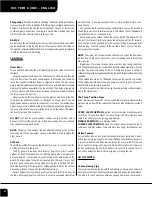
J/105 Owner Guide
......................................................................................................................................................................................................................................................
34
Safety caution: Owners MUST leave the three position pole switch on the bilge pump panel (located
in the nav station area) in the AUTO position in order for the bilge pump to perform properly.
Please refer directly to pump manuals and/or web site information for more about best practices
and maintenance of this component. Finally, it is prudent seamanship to carry replacement parts
for all onboard pumps.
Warning the bilge pumping system is not designed for damage control. The combined capacity of
the system is not intended to drain the craft in the case of accident or damage.
Head System
The J/105 is equipped with one certified Raritan PHII marine head which is capable of
discharging effluents into the standard 45 liter (12 gallon) holding tank or overboard. The
system is easy to operate and with correct usage and proper maintenance, will provide many
years of use. IMPORTANT -‐ Owners should familiarize themselves with all local and federal
regulations regarding proper discharge and avoid inadvertent discharge at all times. A Y-‐valve is
fitted to the discharge line in order to direct the discharge flow to either the holding tank or
overboard. It is shipped from the factory bolted into place such that the flow defaults into the
holding tank.
Before operating the HEAD, ensure you have read its manual thoroughly and understand the
proper procedures. Silly mistakes can cause severe “head” aches at the worst possible time!. And
a word to the wise
PLEASE TRAIN YOUR GUESTS ON HEAD OPERATION. NEVER ASSUME THEY KNOW HOW TO
USE IT.
The head is a large pump which takes in seawater and flushes waste into the holding tank or
overboard. The water intake seacock is located under the V Berth, and the discharge seacock is
under the head sink. Remember the open/closed positions on these thru-‐hulls. It is good
seamanship to close both the intake and discharge seacock when not in use.
When seawater and effluent are pumped through the head, they’re pumped into the holding tank
by the action of pumping the toilet handle. The waste discharge fitting on deck is provided so a
Shoreside pump-‐out station can empty the tank. Care should be taken not to overfill the holding
tank as effluent can block the vent hose and may damage the tank... or worse, burst the hose. If
the toilet is difficult to pump, check to see if the holding tank is overfilled. “When in doubt, pump
it out!” A great resource for understanding and maintaining a marine head system is a book
called “Get Rid of Boat Odors” by Peggie Hall -‐ Seaworthy Publications.
Recommended Head Cleaning Solutions:
Holding Tank -‐ Use fresh water and one gallon of white vinegar solution… flush out twice. There
are also several holding tank treatment solutions available through local marine stores.
Head -‐ refer to the head owner manual for proper cleaning solutions and maintenance.
Pumping a quart of fresh water type anti-‐freeze through the head system and hoses will prevent
the seals and equipment from cracking. The following hoses are connected to the tank.
Summary of Contents for 105
Page 1: ......
Page 2: ...J 105 Owner Guide 2 J 105 Owner Manual HIN Yacht Name Owner Name COPYRIGHT J BOATS INC 2012...
Page 16: ...J 105 Owner Guide 16 Diagrams Layouts Schematics Running Rigging Deck Hardware Layout...
Page 17: ...J 105 Owner Guide 17 Mainsheet Cunningham Diagram...
Page 18: ...J 105 Owner Guide 18 Steering System...
Page 19: ...J 105 Owner Guide 19 Fuel Exhaust System...
Page 20: ...J 105 Owner Guide 20 Thru Hull Seacock Locations...
Page 21: ...J 105 Owner Guide 21 Manual Fresh Water System...
Page 22: ...J 105 Owner Guide 22 Head Holding Tank Schematic...
Page 23: ...J 105 Owner Guide 23 12V DC Layout...
Page 24: ...J 105 Owner Guide 24 Battery Wiring System...
Page 25: ...J 105 Owner Guide 25 Lightning Bonding System...
















































